173 Search Results for preschool
December 16, 2013
by Carole Zangari -
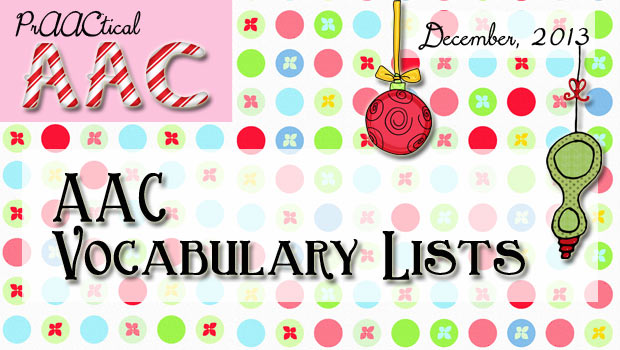
We were looking for some core vocabulary lists the other day and it struck us: Maybe you were, too! Here are some we found, both for core words and other AAC-related topics. Core Vocabulary Adults – Baladin& Iacono, 1999 via Minspeak.com Adults – Hill, 2001 via Minspeak.com Toddlers – Banajee et al. 2003 via Minspeak.com Children [UNL] Preschool Children – Marvin et al. 1994 via Minspeak.com Children (combined sources) – Anderson & Bitner, 2013 Common core related words [UNC CLDS] Young adults [UNL] Older adults [Stuart, et al., 1997, via Minspeak.com] Various classroom, academic, and related lists [Gail Van Tatenhove] ALS [UNL] Break time at work [UNL] Dolch words: PreK through 3rd grade Medically-oriented [UNL] Young children [UNL] Know of one that we should add to the list? Please comment or get in touch so we can add it in. ::::::::::::::::::::::::::::::::::::::::::::::::::::::::::::: UNC: University of North Carolina UNL: University of Nebraska-Lincoln
October 31, 2013
by Robin Parker -
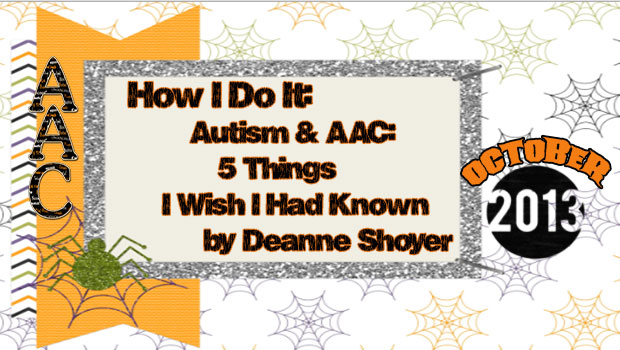
We are so pleased to have connected with Deanne Shoyer from Small But Kinda Mighty and even happier that she is our guest blogger today. Deanne is a mom of twin boys who both are on the autism spectrum. Deanne successfully fundraised to buy iPads for her boys and has been active for more than 3 years in social media and in the special needs app community. She has written about many things but often focuses on implementing AAC in a very PrAACtical way. Please feel free to share this very important post as she highlights AAC, what she has learned, and how it may help others. by Deanne Shoyer at Small But Kinda Mighty (original post at Small But Kinda Mighty) In the title of this post I’ve linked autism and AAC for a specific reason. A lot of the points here are equally applicable to people who have a... [Read More...]
October 17, 2013
by Robin Parker -
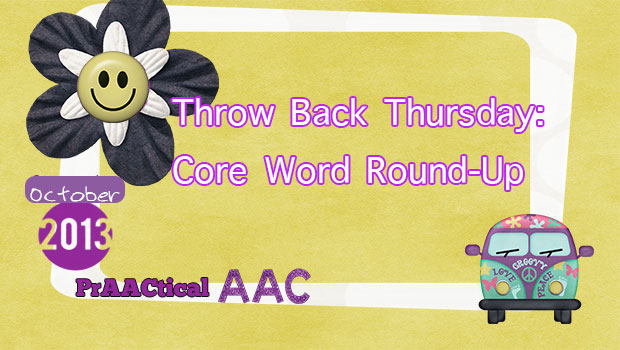
Core Word Round-up! Core Word PrAACtice Ideas Magic Moments: AAC Intervention with Stop and Go App Magic Moments with Toca Store Magic Moments with Sentence Builder Magic Moments with Verb Circus HiJAACked! Putting an AAC Twist on Gen Ed AACtivities: The Hallelujah Flight AAC Goes to PreSchool 5 PrAACtical Uses for Flashcard Apps Visual Language, Core Words, & Martin Luther King Can I Ask You A Question? Breakthroughs with Bubbles with Tanna Neufeld 14 Valentine’s Day Activities, Love, Literacy, & Learning AAC Learning with Play Dough by Jamie Cooley 5 Ways to Use Power Point in AAC Intervention 5 PrAACtical Thoughts on Catch-Up Conversations How I do It- Marlene Cummings Shares an Implementation Toolbox AACtual Theray with Tanna Neufeld- Use Your Best Spud To Teach Vocabulary How I Do It- Marlene Cummings On Strengthening the Communication... [Read More...]
August 30, 2013
by Robin Parker -
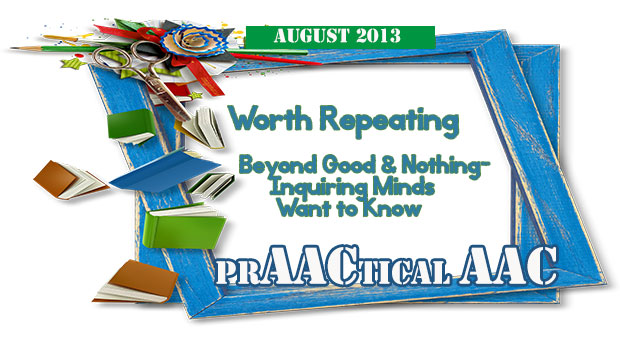
by Carole Zangari, originally published on August 27, 2012 “How was school?” (Good) “What did you do?” (Nothing) This scenario plays out in many cars and kitchens in the after school hours and it can be hard to know who is more frustrated: the kids for being asked or the parents for not getting satisfactory answers. And still, we repeat the process day after day. Of course, we want to know the fine details of what happened and how our children felt, but in some cases, we’d settle for ANY school-related conversation at all. I’ll be the first to admit that it took me way too long to get the hang of how to get information about my children’s school days, and it seemed like just when I did, pow! They were pre-teens and then teenagers. New rule book. Here are some ‘lessons learned’ along the way about those afterschool conversations and... [Read More...]
April 20, 2013
by Carole Zangari -
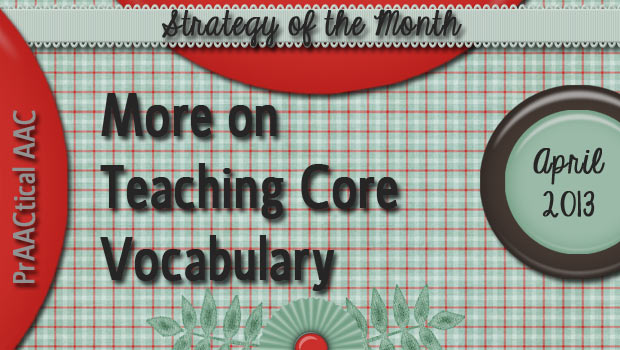
Last week, we talked about two key strategies for teaching core language: using aided language input and creating frequent opportunities to teach and elicit core words. In today’s post, we’ll expand the number of words and discuss two additional considerations for teaching core words. Aided language input is always important in working with beginning users of AAC. It exposes them to their new means of communication, provides them with a competent model of their AAC system, and introduces them to words and symbols they don’t yet know within a meaningful context. It also forces us to slow down when talking, something that can be very beneficial when you consider that many beginning users of AAC also have difficulty processing oral language. (It may take them longer to decode what they’re hearing and they may have to concentrate more than the average kid.) If you’ve actually tried pointing to symbols as... [Read More...]
April 15, 2013
by Carole Zangari -
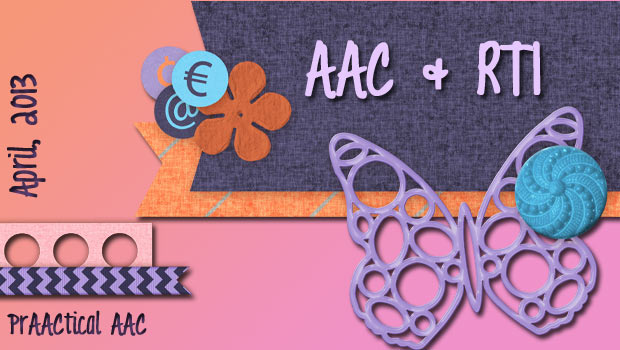
Most American schools are implementing some form of a service delivery model called Response to Intervention (RTI). In this post, we bring you an article by Drs. Sandy Grether and Linda Sickman on how the tiered system of supports in RTI can be applied to students with AAC needs. They discuss the role of the SLP and explain best practices in supporting AAC learners using this approach. Their article was part of a special issue entitled ‘AAC from Preschool to High School: Building Success with Evidence-Based Interventions,’ guest edited by Karen Fallon. The online version, available here, is hosted at the University of New Hampshire. Grether, S.M, & Sickman, L.S. (2008). AAC and RTI: Building classroom-based strategies for every child in the classroom. Seminars in Speech and Language, 29, 155-164.
April 4, 2013
by Carole Zangari -
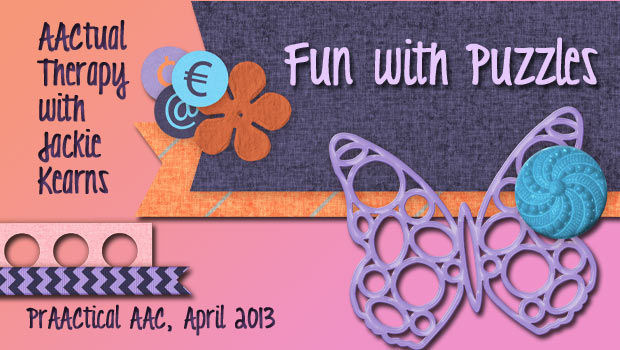
Today, we’re pleased to introduce SLP Jackie Kearns, coordinator of the Technology Resource Center at the Cleveland Clinic Children’s Hospital for Rehabilitation. Prior to that, she received her bachelor’s and master’s degrees from Ohio University. She completed both an undergraduate and graduate level thesis and has published in Contemporary Issues in Communication Sciences and Disorders. Jackie has over 5 years’ experience working with medically complex children in both inpatient and outpatient hospital settings. She has provided numerous AAC evaluations and treatment for children ranging from 1-21 years of age. In addition, she has done numerous presentations and in-services for staff at the Cleveland Clinic. We’re grateful to Jackie’s AAC professor and mentor, Dr. John McCarthy for recommending her to us. Therapy Activity: Fun with Puzzles Intended audience: Early intervention, preschool aged children, and/or emergent AAC communicators Type(s) of AAC: Eye gaze, reaching Picture communication symbols Single message voice output communication... [Read More...]
April 3, 2013
by Robin Parker -
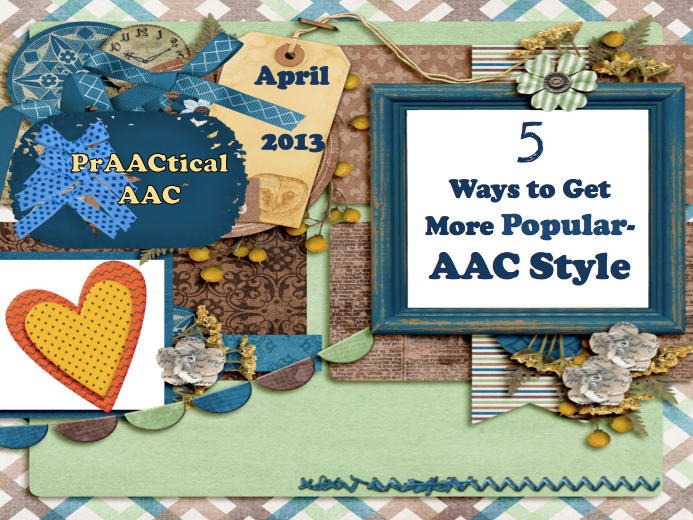
Popularity may or may not be important to children or adults, but most of us would like to have some friends and at least some people we can share information with. From a facilitator’s point of view, we need AAC users to have conversations with a variety of people. The more prAACtice in conversational exchanges the better. We have learned (through research and clinical experience) that if we teach specific skills, communication partners are more likely to initiate and respond to AAC communication. Here are things to teach for ‘conversational’ popularity 1. Teach Partner Focused Questions What’s up? How are you doing? How is your family? How are you feeling? What are you thinking? 2. Teach Social/Participation Scripts Attention Getters Starters Maintainers Turn Transfers Closings Let’s talk. Guess what? And next.. What’s your thoughts? That’s it. Come here. Let me tell you something. want a hint? Amazing right? See you later.... [Read More...]
March 16, 2013
by Carole Zangari -
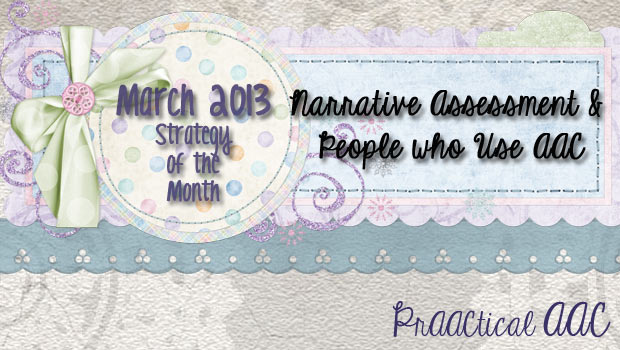
This month, we’ve been talking about building narrative skills in our AAC clients. We tried to build the case that including narrative language goals in our intervention allows us to help people who use AAC to participate more fully in social exchanges, relay more in-depth information, and achieve greater academic success. But how do we know where to start in narrative intervention? And how do we measure progress? In this post, we share some thoughts on the assessment of narrative language in AAC. Most test batteries that assess narrative language are designed to take a snapshot of what the learner has already mastered in terms of telling personal narratives, story retelling, or scripts. This allows us to look beyond MLU, morphology, and grammar and can be useful in determining whether intervention is needed. Some scholars, however, have noted the limitations of this “one shot” approach, particularly for learners whose communication... [Read More...]
March 2, 2013
by Carole Zangari -
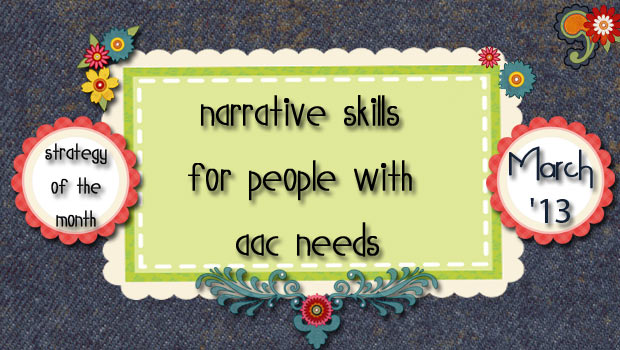
This month, we’ll share some thoughts about helping people with AAC needs develop narrative skills. Why narrative skills? Because they help us connect to one another and communication learning works best when we feel connected. Among other things, storytelling helps us relate to one another. Narrative language is important for reading and writing skills to develop. It helps us understand the world and ourselves. In telling our stories, we establish our identities. Plus, it’s part of what makes life fun. In the US, pediatric therapists are having lots of conversations about the Common Core State Standards (CCSS) in English Language Arts (ELA), and how they relate to the IEP goals of the students that they serve. Many of the goals in the ELA speaking domain require students to be able to summarize what they hear and read, so it is no surprise that SLPs are prioritizing narrative language and related... [Read More...]









